List of Authors
>>About this blog
Recent blog post
|
[Dimini ☆ Cricket]
February 17, 2019 14:00
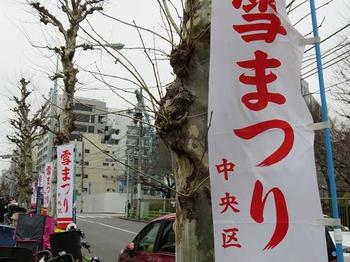
Once every two years, the Chuo-ku Snow Festival , which is held as an annual winter event, was held at Akatsuki Park. , which is held as an annual winter event, was held at Akatsuki Park.
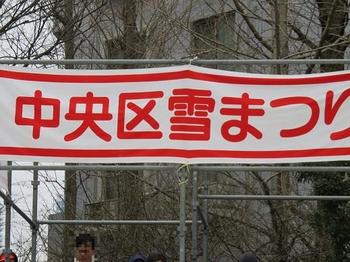
This is the 20th time.
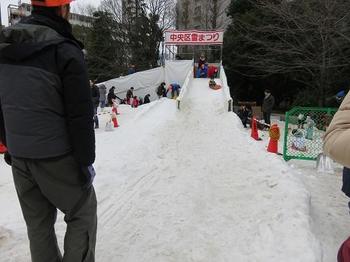
It was Sunday, February 10 and the 11th of holiday.

This snow  is provided by Higashine City, Yamagata Prefecture, a friendship city in Chuo-ku, and is held every other year with the cooperation of many local people, such as the town council, the Youth Measures District Committee, and the PTA. is. is provided by Higashine City, Yamagata Prefecture, a friendship city in Chuo-ku, and is held every other year with the cooperation of many local people, such as the town council, the Youth Measures District Committee, and the PTA. is.
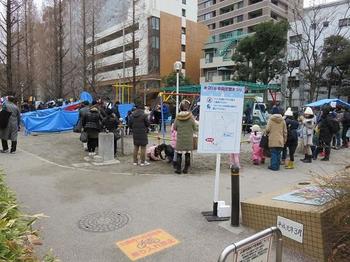
When I  went to lunch on Monday, the eleventh, there was a great crowd. went to lunch on Monday, the eleventh, there was a great crowd.
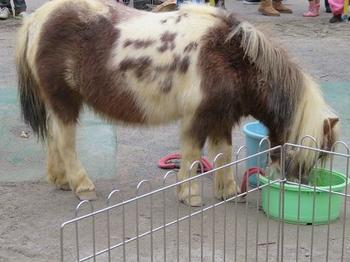
There was a corner where you could play sleds and miniskies , a corner where you could ride ponies, touch rabbits and marmot, and a hot food corner. , a corner where you could ride ponies, touch rabbits and marmot, and a hot food corner.
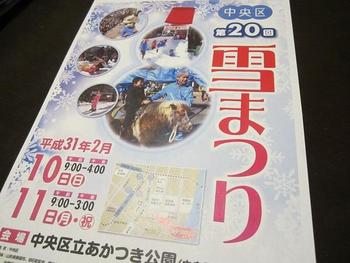
     
[rosemary sea]
February 17, 2019 12:00
This is rosemary sea, which covers "gifts and enjoy yourself" based on popularity.
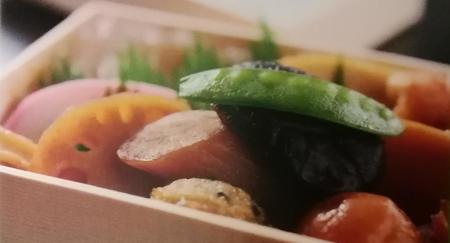
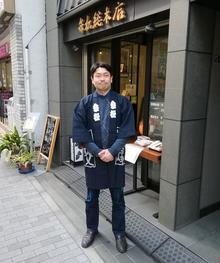 According to the "First Time Story Map" issued by the Chuo-ku Tourism Association, Nihonbashi Benmatsu Sohonten is introduced as "the shop of the Orizume cuisine specialty store". According to the "First Time Story Map" issued by the Chuo-ku Tourism Association, Nihonbashi Benmatsu Sohonten is introduced as "the shop of the Orizume cuisine specialty store".
"Dark taste. The taste of Edo Nihonbashi. Benmatsu, who has been very famous for a long time as a lunch box.
This time, I would like to introduce this shop that was founded in Kaei 3 (1850).
However, I will introduce the history of Mr. Benmatsu in detail later.
Mr. Junichi Higuchi, Representative Director of Nihonbashi Benmatsu Sohonten Co., Ltd.
It is the eighth generation of Benmatsu-san.
In the eighth generation, we will also introduce interviews and the history of Nihonbashi.
Then I would like to introduce some items. All prices are tax-included.
First of all, from lunch box ...
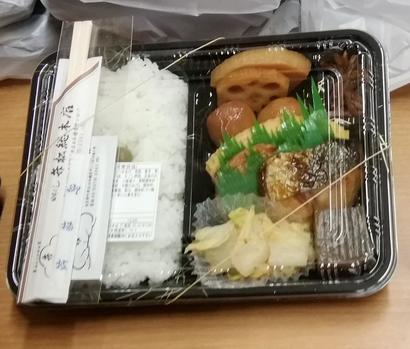
Lunch lunch 650 yen
It's a very reasonable dish.
Benmatsu's lunch box and side dishes (Daimaru Tokyo store is only lunch box) are sold at Mitsukoshi Nihonbashi / Ginza store, Nihonbashi Takashimaya, Isetan Shinjuku, Seibu Ikebukuro / Shibuya store, Chiba Sogo department store stores as well as supermarkets, but this lunch box is limited to the main store.
The lunch box from here is the price of white rice.
Red rice is increased by 150 yen before tax, and single dishes are reduced by 240 yen before tax.
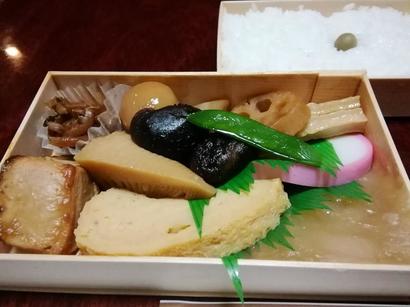
Nanroku (Nami Roku) 1,080 yen
It's the most popular. It's a good idea to introduce this first.
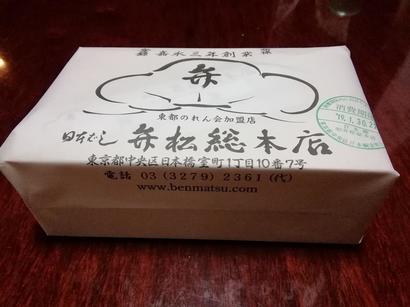
I received this.
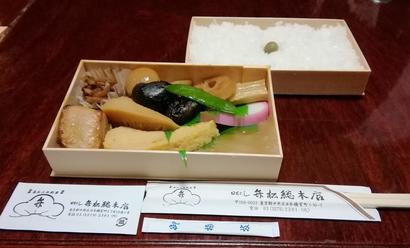
"Each ingredient is well seasoned and delicious.
The taste is great because of the folding of Kyogi." Rosmali family.
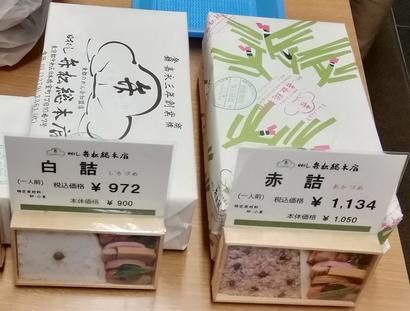
Left: 972 yen (Shirozume)
It's the most popular. It's a classic white rice.
Right: Akazume 1,134 yen
The red color is said to purify evil spirits. It's essential for the celebration.
Of course, you can have red rice normally.
・・・ There are many other types of lunch boxes. Would you like to make a reservation?
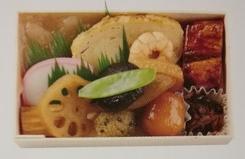
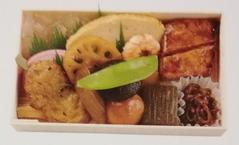 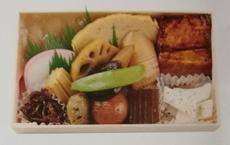
Above: Namirokujo 1,232 yen
Lower left: 1,556 yen, 1,556 yen
Lower right: 1,718 yen (Nanana)
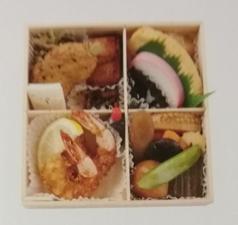 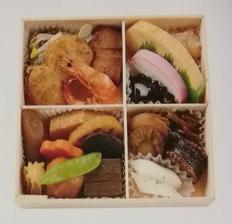
Left: Box valve folded (Hakoben Orizume) 1,890 yen
Right: Shunsai Hakoben, 2,106 yen
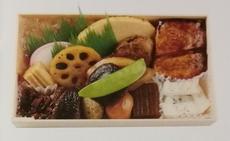 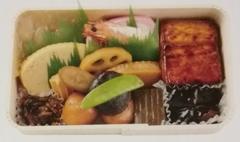
Left: 2,031 yen (honna)
Right: Hon-Nanamaru 2,344 yen
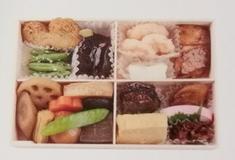 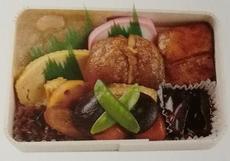
Left: Edo taste (Edo Aji) 2,355 yen
Right: Namihachimaru (Namihachimaru) ¥2,690
・・・ From here, we will introduce the dishes, that is, the price without rice.
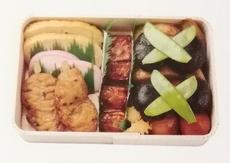 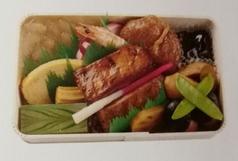
Left: 2,312 yen for two-person (Ninmae)
Right: Nami Kyumaru (Nami Kyumaru) 3,456 yen
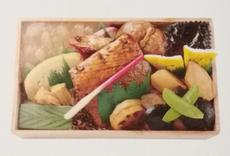 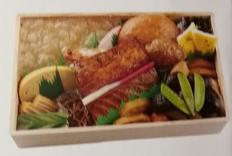
Left: Kyusinsugi 7,992 yen
Right: Shakuichisugi 10,044 yen
In addition, there are also 4 dishes with sea bream tail. It's between 3564 yen and 10476 yen.
Benmatsu's lunch box is inevitable sold out. Please make a reservation by phone.

Nihonbashi Benmatsu Sohonten
1-10-7, Nihonbashimuromachi
3-minute walk from Mitsukoshimae Station on the Tokyo Metro Hanzomon Line and Ginza Line.
03-3279-2361
Business hours Weekdays 9:30 to 15:00
Saturdays, Sundays, and holidays 9:30-12:30
Telephone reception Weekdays 8:30-16:00
Saturdays, Sundays, and holidays 8:30 to 13:00
Click here for the homepage of Nihonbashi Benmatsu Sohonten.
⇒ http://www.benmatsu.com/
[Hanes]
February 17, 2019 09:00
Hello. This is a new correspondent, Hanes. 
I went to the "Chuo-ku Snow Festival" held at Akatsuki Park on Sunday, February 10 and 11 (Mon / holiday). .
Since it is held every other year, it is my first snow festival since I moved to Chuo-ku....
I've been looking forward to it since the end of last year!
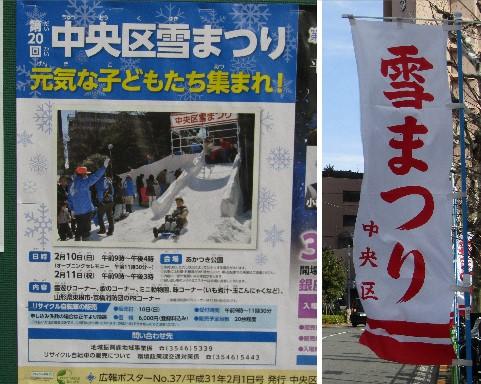
On the 9th (Saturday), the day before the event, it was very cold, and although it was hardly piled up, snow fell.
Meanwhile, the amount of snow delivered from Higashine City is equivalent to 20 trucks ! !
In Tokyo, the amount of snow that you don't see first increases the tension even for adults.
This time, I would like to tell you about such a snow festival.
■Snow play corner
Here we slide the snow slope with sleds.
I was able to play with the snow while I was in Tokyo.
For children in Tokyo who don't usually see so much snow,
I guess it was a great excitement.
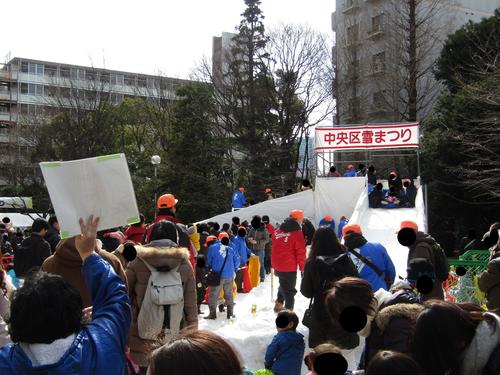
Like sleds, there was a long line of miniskies.
Ski boards and stock for children can be borrowed from Chuo-ku.
You can enjoy skiing easily.
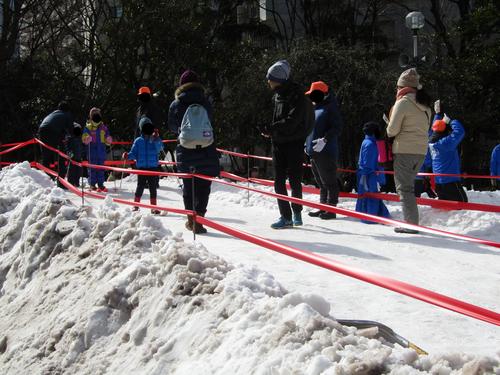
In addition, parents and children make snowmen, etc.
I saw him enjoying playing with the snow as he wished.
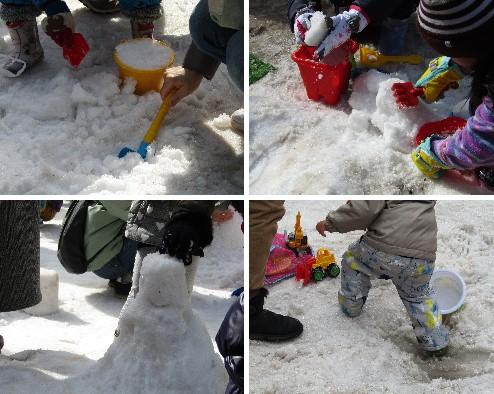
■Mini zoo
You can ride ponies, ducks, chickens, etc.
Cute small animals such as rabbits were also coming to play.
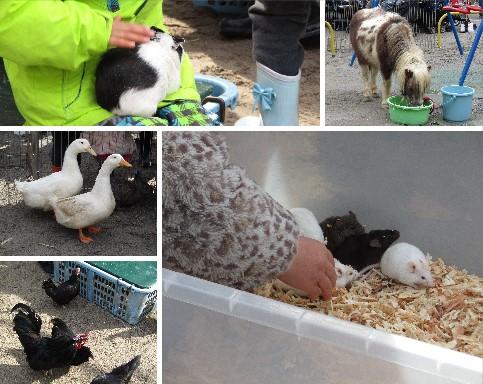
■Song Corner, Opening Ceremony
In the song corner, which was held twice a day, the song was held.
Including Panda Rabbit koala, which children can enjoy together.
Various songs are performed, and there are many smiling children around the stage.
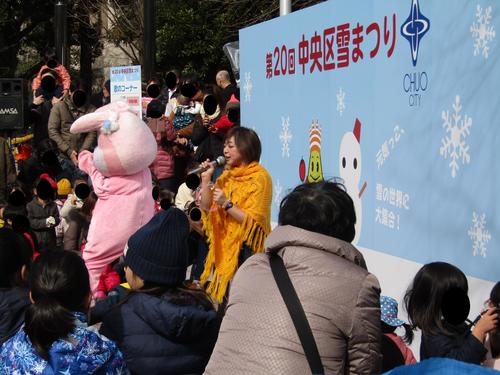
(It is a pity that we cannot deliver the expression due to the protection of personal information.)
And on the 10th, the opening ceremony was held from 11:30.
I missed the timing for a moment.
I was able to meet the mayor of Chuo and the local character of Higashine City, the king of the fruit tree kingdom, Tanto-kun.
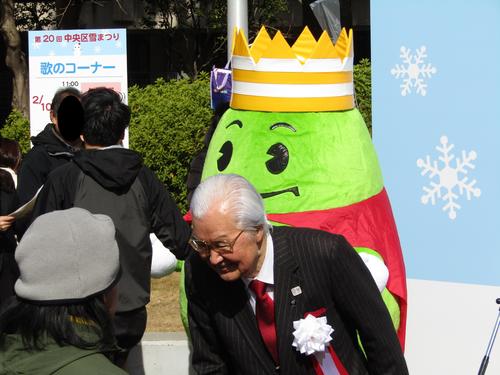
■Higashine-shi PR corner
In a corner of Akatsuki Park, special products of Higashine City were sold.
Among them, many of them were Keio Sakura.
It is a cherry blossom that blooms in winter and is a representative cherry tree in Yamagata Prefecture that delivers spring a little earlier (how, the shipment volume is the highest in Japan ). ).
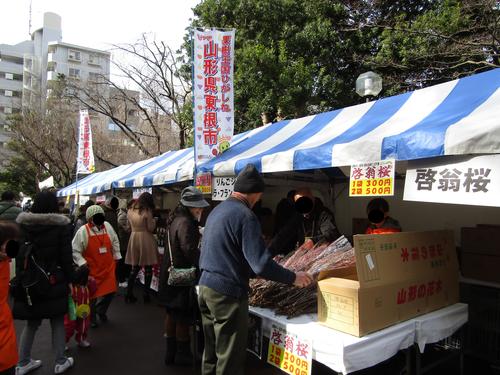
There are also juices, fruit wines, sweets, etc. made from fruits from Yamagata.
Lotteries that can be participated if purchased over a certain amount of money were also exciting.
Meanwhile, I purchased "Keyaki-yaki" from Shosendo, famous for "Kotobuki Matsu" in Yamagata famous confectionery.
What is the reason?...Chuo-ku and Higashine-shi also have exchanges through keyaki.
I think that it is only the exchange between cherries and willows, and in the ward administration yearbook,
On February 11, 2007, it is recorded that the "15th anniversary of the Chuo-ku-Higashine-shi friendship city tie-up" was held.
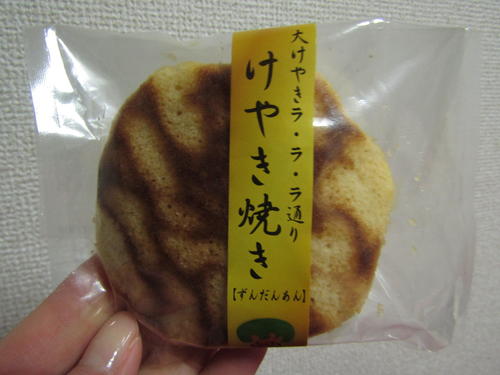
It is the most important taste, but it has a modest sweetness, and the flavor of the dough is very good.
In addition to green soybeans, white hide beans are added to Zudaan.
I think it was more like "an"!
And some of the visitors knew for the first time that this snow festival was used as an opportunity.
Once again, I felt that such cultural exchange was meaningful.
■Sales of recycled bicycles
Recycled bicycles were sold on the morning of the 10th, saying, "Treasure limited resources."
Those who wish to purchase must put the prescribed application form in the envelope attached to the desired bicycle by 11:30.
The lottery will start from 12:00.
This time, about 20 units, which were dominated by the city cycle, were sold.
The appeal of this project is that it costs 6,000 yen per bicycle including the security registration fee (* cash payment is required on the spot).
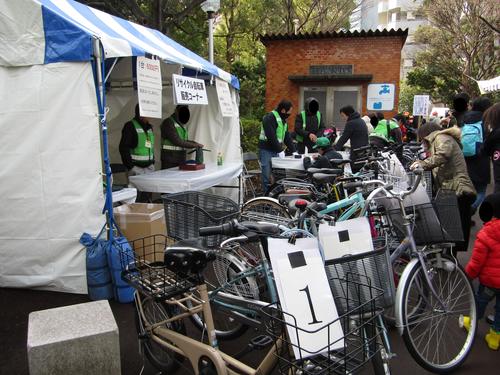
The applicants were slightly different from 2 to 30 people for each bicycle, but many people participated in the lottery.
Recycled bicycles are all clean and well maintained.
Isn't it a great opportunity for those who are considering purchasing a bicycle?
This tent will be the Kyobashi fire brigade PR corner on the 11th the following day.
It seems that they have distributed leaflets.
■Taste corner
Here you can find regional cuisine, Gomoku rice, fried rice soup, taiyaki, oshiruko, hot Calpis, and so on.
Food and drinks that can be enjoyed by adults and children were distributed, and it was very busy.
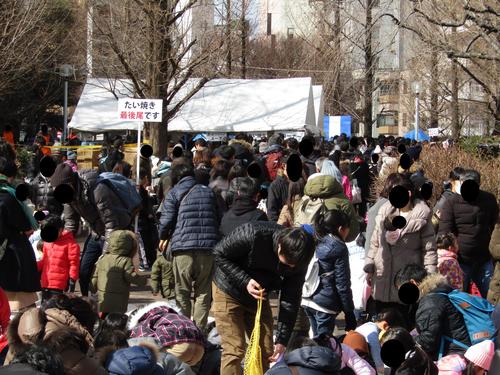
When I visited Higashine at the beginning of the year, I lost eating local cuisine like regional cuisine.
I also had potato broth, tamakonjac, and taiyaki.
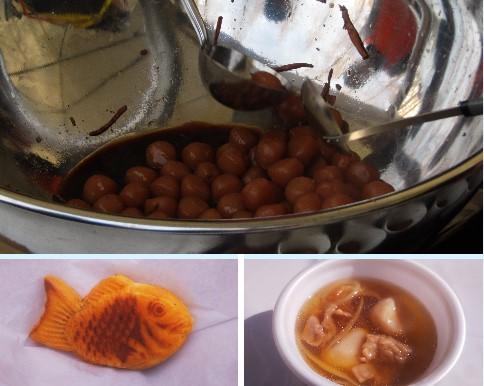
The taste of pork is very effective in the potato broth.
Some of them commented, "Sukiyaki-like!"
The tamakonjac, which was moderately elastic and tasted, was also delicious.
■Yeah
The Chuo-ku Snow Festival, which was participated for the first time this time, was a unique winter event with various projects and corners.
There is a feeling of being for children, but it can be enjoyed regardless of men and women of all ages.
I guess it's not the only one who felt wasteful at every other year.
And it was surprisingly crowded with so many families, saying, "There were so many children in Chuo-ku!"
In Chuo-ku, there are many valuable opportunities for children to enjoy, including Kabuki and traditional festivals.
You are enjoying Chuo-ku with your child
As you can see from the articles of senior correspondents, Edamame, Osome, and Harumi Madam (in alphabetical order) and conversations when they appeared on the radio.
I feel like I was able to understand more that "Chuo-ku is easy to raise children"
I was able to know the charm of the friendship city, Higashine City through snow, gourmet, special products, etc.
There was also information newly obtained, and I wanted to visit again soon.
[Satoken]
February 16, 2019 18:00
Kameshima Bridge is a bit plain among many bridges in the city, but there are some highlights.
On the other side of the "Horibe Yasubei Takeyuki Monument", "Ginza Yanagi Shisei", "Basho's Monument", and "Sharaku Toshusai" and "Tadataka Ino" are described as "people who have moved to this area (Hatchobori) and have been able to convey their achievements". There is an explanation of. It's a pity that stone monument's wooden explanatory version is barely readable. There are many highlights that are not found in the Monoshiri Encyclopedia, and it is interesting to walk in search of such places.
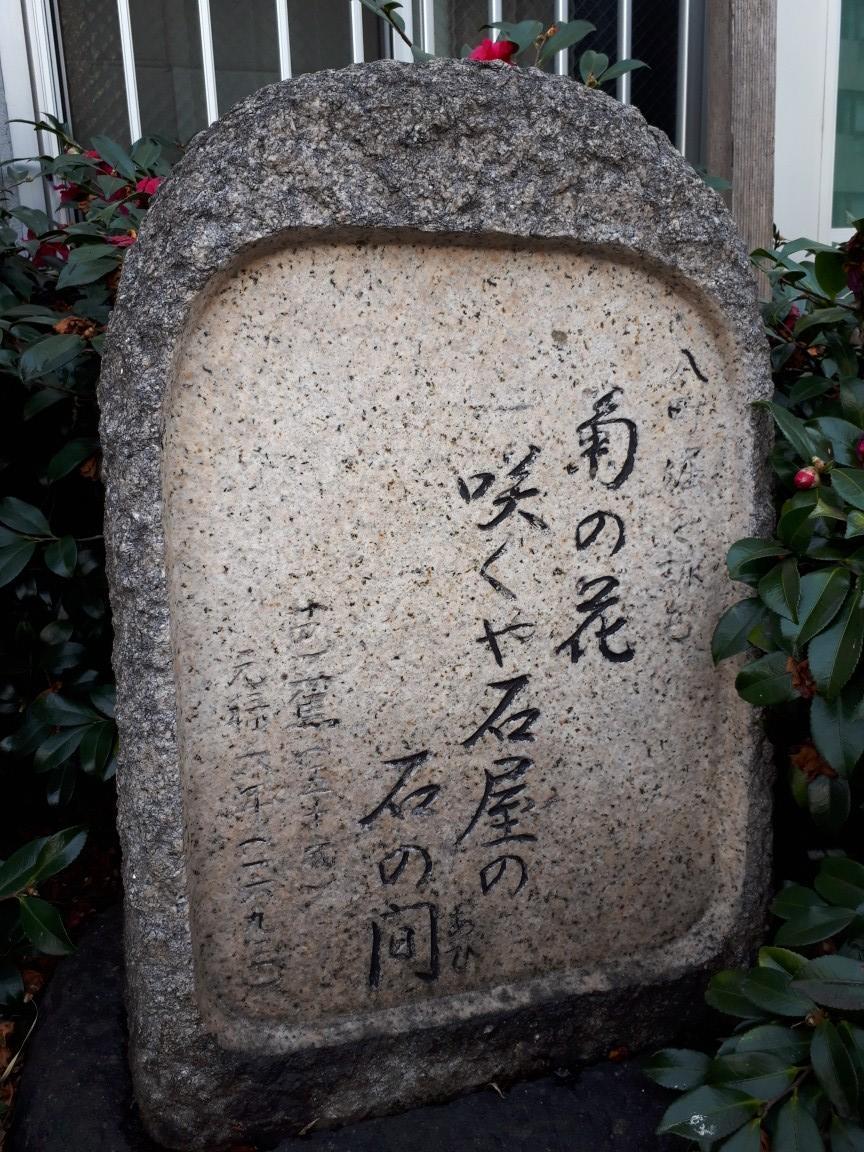
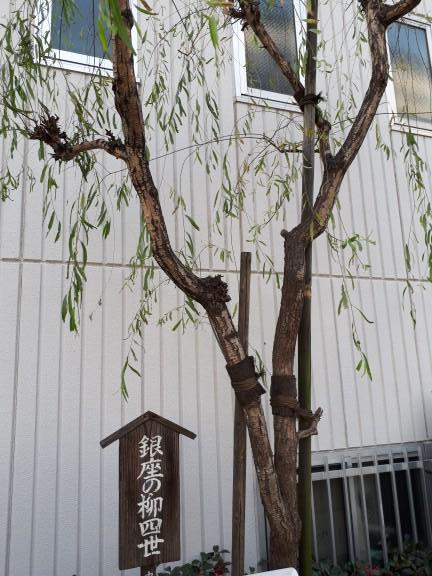
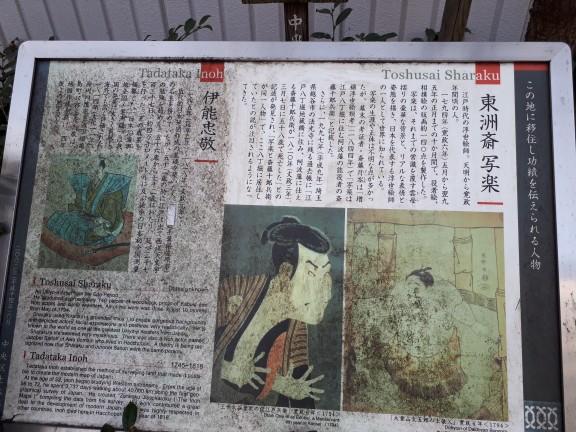
[Edamame]
February 16, 2019 12:00
This is Edamame, a correspondent with children.
Continuing from the previous time
/archive/2019/02/11-14.html
From the "11th Chuo-ku Tourism Certification" conducted on February 3
I would like to pick up the problem that Edamame was concerned about.
Q50 The shipping bridge was a bridge over the maple river.
Because the river was reclaimed and turned into a highway, the bridge was removed.
At present, only two main pillars are left.
One main pillar is engraved with the word "Kayunhashi".
Which of the following characters are engraved on the other main pillar?
A. I'm gonna Kaiunbashi Bridge U. Sakamoto-cho e. June 2,535 BC
To excuse ...
Surely, just before I became a correspondent,
When I was walking around Chuo-ku with an official textbook in my hand to study for the exam
The shipping bridge was definitely coming.
Yeah.
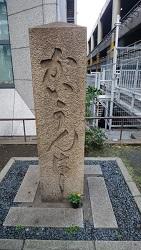
Despite the fact that the text says "two main pillars" properly.
This is the main pillar of the person who wrote "Kayunhashi"
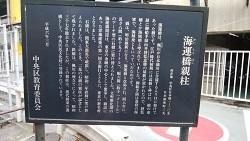
I was satisfied when I saw the explanation board of the Board of Education. Maybe.
That's why I don't have a memory of "another main pillar" ...
※In the official text, there is also a description of "what is written".
Let's read and study properly.
So why didn't you notice it?
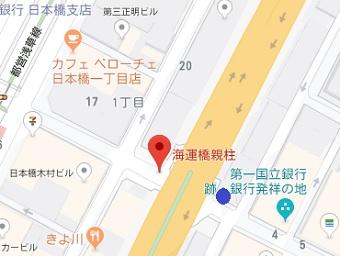
↑The main pillar and information board of "Kayunhashi" written with a large red mark
Former riverbank (?) On the other side of the highway, which was former maple river. For you
There was "the other main pillar." (Aomaru on the map)
So it was hidden behind the elevated highway,
I wasn't able to recognize the existence properly.
So let's go see it with you.
The correct answer is ...
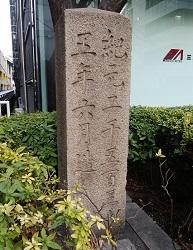
Here you.
D. June 2,535 BC
I did it!
By the way, what is "2535 BC"?
It was due to the Imperial Ki, whose first year was the throne of Emperor Jimmu.
2535 = 1875 = 1875 = 1875 AD.
It was that year when the shipping bridge was replaced with an arched stone bridge.
It is close to the main pillar of "June 2,535 BC" ...
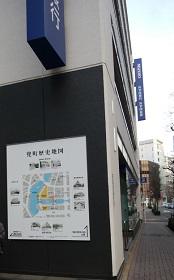
There is the Mizuho Bank Kabuto-cho Branch.
That's right. Here is
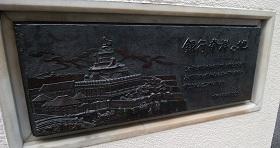
It's the birthplace of the bank.
In 1873, the "Daiichi National Bank" was established here.
During the Civilization and enlightenment period, there was also a new and wonderful Western-style bank.
It has become the capital of Tokyo's financial center.
It seems that this neighborhood has become a "new famous place in  Tokyo Tokyo ". ".
Electronic trading of stocks has become the mainstream.
There is no so-called "place standing"
It is said that Kabuto-cho is no longer bustling than before.
However, it is also an area adjacent to Nihonbashi.
It seems that the redevelopment plan of the city is gradually being promoted.
I would like to look forward to the appearance of Kabuto-cho, which will become a new attraction in in  Tokyo again. Tokyo again.
[yaz]
February 16, 2019 09:00
I was in charge of a guide for "Ningyocho-Higashinihombashi" in the training of a certain guide club, and as a guide for the "Tsukiji" and "Ningyocho" districts, I investigated the interest of Asakusa Mido.
Tsukiji Nishi Honganji Temple is the reconstruction of Nishi Honganji Temple in Asakusa Hamacho, which was destroyed by the great fire of the Meiryaku era. Asakusa Mido, the original Nishi Honganji Temple, was founded in Asakusa Hamacho in March 1621. The location is the back of Machiya, 2-chome, Yokoyamacho. In Kanei 2 (1625), the Shogunate officially recognized as a separate hospital and became "Nishi Honganji Temple". It is also known as "Edo Seaside Gobo" or "Hamacho Gobo".
If you refer to the Edosho map of Bushu Toyoshima-gun, you can see Asakusa Gobo on the east side, just north of Hamacho moat behind Motoyoshihara. (Refer to the cut-out picture below.)
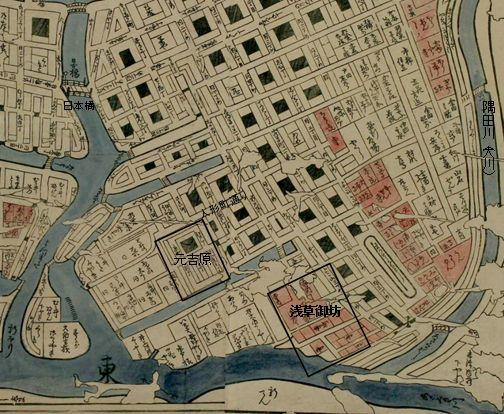
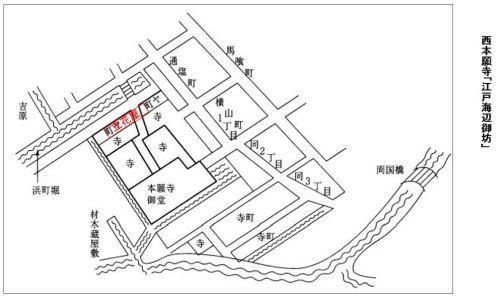
There was a small townhouse on the moat side of Hamacho, branch temple, main hall. It is said that "Tachibana" was sold here, and there is a theory that it was later named "Tachibana-cho".
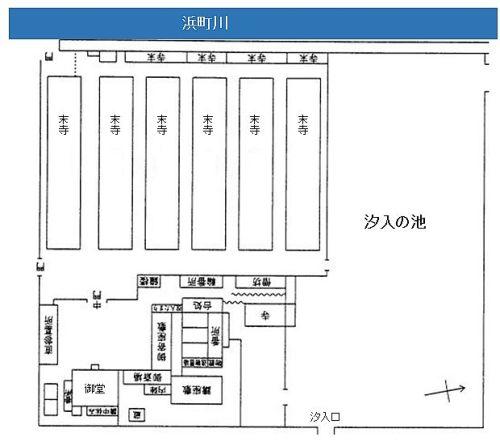 There are 57 branch temples on the premises, Mido's size was 12 spaces (width) X8 spaces (depth), and the direct burial ground on the left side of Mido was 58 tsubo. It is said that the size of Nishi Honganji Temple would have been 20,000 to 30,000 tsubo, given by Matsudaira Echizen Mamoru in the Meiryaku era. There are 57 branch temples on the premises, Mido's size was 12 spaces (width) X8 spaces (depth), and the direct burial ground on the left side of Mido was 58 tsubo. It is said that the size of Nishi Honganji Temple would have been 20,000 to 30,000 tsubo, given by Matsudaira Echizen Mamoru in the Meiryaku era.
The part facing Hamacho moat will be Tachibana-cho later. Tachibana-cho is said to be "Higashibashi 3-chome" on the current map. The area surrounded by the red frame is Higashi Nihonbashi 3-chome.
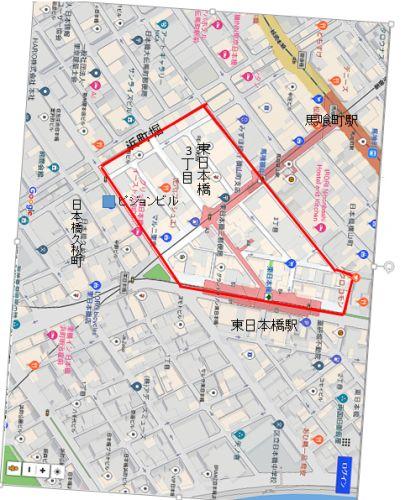
After the great fire of the Meiryaku era, Higashi Honganji Temple moved to Asakusa Sanjusangen-do Temple and Nishi Honganji Temple moved to Hatchobori Tsukiji Temple "Umiai". After the relocation, Nishi Honganji Temple follows a strange fate.
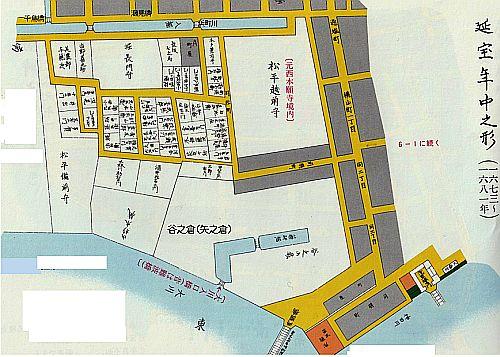
After the relocation of the temple due to the great fire of the Meiryaku era, Terachi was taken up, and the traces of Nishi Honganji Temple and Asakusa Mido were given to Matsudaira Echizen Mamoru of the Fukui Domain, which has strong connection with Junyo, on May 14 of the same year. You. There were 13,000 tsubo. With this in mind, the surrounding area gradually changed its appearance, and on the east side of Matsudaira Echizen Moriyashiki, the land of the Shogunate officials and lent it to townspeople, became a town area, `` Dobo-cho '' (Doho-cho) was born, and the moat drawn behind Asakusa Mido became Yagenbori, and the Yonezo of this area was set up in the Yonezo area, where the salary of the whole area. In the south of the mansion, there is a small town, Muramatsucho, and further south is a samurai residence. Let's refer to "Enpo era Nakanogata" (upper figure) in the Chuo-ku history book. At the location of Nishi Honganji Temple, the ambiguous expression "Yokoyamacho 2-chome South Machiya Ura" is generally made, but if you look at this material, you can nodd it.
Reference:
1) Chuo-ku History Chart
2) Takashi Shiraishi: "Nihonbashi Tachibana-cho Commercial History Memorandum of Understanding - Wholesalers and Town-"
(Mita Business Research, Vol. 41, No. 6, February 1999)
3) Tokyo Famous Places
|
Links
|
![]() , which is held as an annual winter event, was held at Akatsuki Park.
, which is held as an annual winter event, was held at Akatsuki Park.![]()
![]()
![]()
![]() is provided by Higashine City, Yamagata Prefecture, a friendship city in Chuo-ku, and is held every other year with the cooperation of many local people, such as the town council, the Youth Measures District Committee, and the PTA. is.
is provided by Higashine City, Yamagata Prefecture, a friendship city in Chuo-ku, and is held every other year with the cooperation of many local people, such as the town council, the Youth Measures District Committee, and the PTA. is.![]()
![]() went to lunch on Monday, the eleventh, there was a great crowd.
went to lunch on Monday, the eleventh, there was a great crowd.![]()
![]() , a corner where you could ride ponies, touch rabbits and marmot, and a hot food corner.
, a corner where you could ride ponies, touch rabbits and marmot, and a hot food corner.![]()
![]()
![]()
![]()
![]()
![]()
![]()



















































 There are 57 branch temples on the premises, Mido's size was 12 spaces (width) X8 spaces (depth), and the direct burial ground on the left side of Mido was 58 tsubo. It is said that the size of Nishi Honganji Temple would have been 20,000 to 30,000 tsubo, given by Matsudaira Echizen Mamoru in the Meiryaku era.
There are 57 branch temples on the premises, Mido's size was 12 spaces (width) X8 spaces (depth), and the direct burial ground on the left side of Mido was 58 tsubo. It is said that the size of Nishi Honganji Temple would have been 20,000 to 30,000 tsubo, given by Matsudaira Echizen Mamoru in the Meiryaku era.


